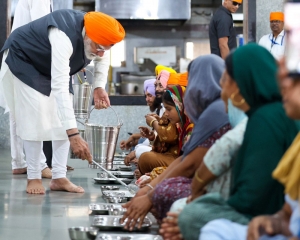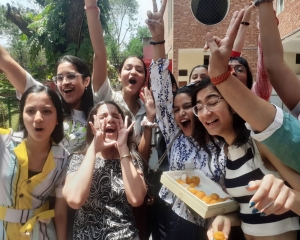Baskets, boats and bridges of cane along with the antique black stone pottery take the shape of cookware and traditional materials. By Uma Nair
Bamboo and clay are the simplest products of nature. Yet the National Foundation for India (NFI), which collaborated with the India International Centre (IIC) to present a three-day festival, Art East, showed how these could stretch the imagination of both the artist and the common man alike. The festival was curated by Kishalay Bhattacharjee, who is an associate professor at a prestigious university.
One of the highlights of the festival was an exhibition and a performative installation called An Ode to Bamboo, a visual journey of how it weaves together all the states of Northeast and beyond through art, livelihood, architecture and everyday objects of use. New media artists — Sukant Panigrahy and Kaur Chimuk — conceived a 22 ft installation titled, An unseen tunnel inside a displaced proletarian that takes the viewer through a tunnel travelling and experiencing the transitional point of green space to grey space — the crisis of ecological disorder and the unsustained urban pressure.
Bamboo traditions and modernity
In the several stunning photographs at the IIC Art Gallery by Parasher Baruahyou, we came across an investigation of bamboo as a material which can be substituted for wood or steel in construction. Bamboo, a natural raw material, is one of the fastest growing plants on earth. Its use in construction is not new and has been regularly utilised for building mud houses and small huts in villages for centuries — as seen in these photographs.
Bamboo is a durable and exceptionally flexible building material. It has been utilised for flooring, walls, roofing, concrete reinforcement and scaffolding. It is light in weight and easily transported. It has multiple environmental benefits too.
The Bamboo Bridge as an image tells us that numerous practitioners are also inspired by these building traditions, given that the locals are naturally energy-efficient and green, honed as they are by local resources, geography and climate. However, given the diversity of vernacular architecture in the global context, the techniques or technology-based research on vernacular architecture remains surprisingly limited beyond performance-based examples. This limitation stems from multiple factors, one being fundamentally hinged on the conventional notions of “traditional” and “modern” in the discourse of architecture.
In the discussion of vernacular architecture — the words “modern” and “traditional” are often considered as being in fundamental opposition to each other. One tends to suppose that vernacular architecture is on the lines of traditional architecture, distinct from the modern practices of construction. In this dualist view, the traditional is taken to be inept or technologically crude.
However, a fragmented volume of vitally grounded works on Asian vernacular dwellings suggests that materiality, as well as adaptive and smart-space solutions and techniques are deployed ingeniously as much (or more so) by the local unknown builders in a traditional setting along with the support of illustrious architects. While the installation created did not do justice to the prototype design image that was placed alongside, it gave us a vision of the intention of space.
Black clay pottery
At the Gandhi King Plaza, the trees were embellished with a collection of black clay pots encircling the expansive space. For centuries, Manipuri people have used stone pottery to cook their food. This is aesthetically appealing and looks fine alongside the most sophisticated modern cookware in our kitchen.
However, Manipur’s traditional black stone pottery can justifiably boast of several general and health benefits that our modern cookware simply cannot. The rocks contain naturally-occurring iron. When one cooks in these pots, the heat infuses the food with the iron.
The raw materials used are weathered rock and serpentine rock, which according to locals, are available at longpi Manipur alone. The two rocks are crushed to a powder and mixed with water in a ratio of 5:3 to form a clay-like consistency. The dull-brown mixture is kneaded the entire day and flattened on a wooden board for the initial slab work. Uniquely, longpi pots are not crafted on a potter’s wheel. Every item is shaped by hand with the help of moulds and tools. Once the shaped clay has dried and is hard enough, it is taken to an open bonfire and heated for five to seven hours at temperatures over 1200 degrees centigrade.
The pottery is taken out when still hot and scrubbed with a local leaf known as the machee, giving it a smooth finish and nice shine. The final products are grey-black cooking pots and kettles. Also aesthetically appealing bowls, mugs and trays are frequently accompanied with a lacing of fine cane at the handles and knobs. They have a distinctly earthy, yet contemporary appearance.
The pots made in Meghalaya are made by the women — a small group of women from Tyrshang village produce some the most exquisite hand-made pottery that is not only used locally for preparing the Khasi putharo but is also meant for religious purposes.
Apart from the Doloi, who use the pottery produced by the womenfolk of this village for religious practices, their products are also internationally acclaimed and specifically in high demand in countries like Japan and Korea who import their goods and use them for their religious practices as well.
The significant aspect of why their pottery is renowned internationally perhaps lies in the pottery-making tradition of the people of Tyrshang who have continued to produce fine products by simply using their hands throughout the process. They do not use a single mould for it. Moulds accelerate output but deteriorate the quality. To know that these black clay pots are created without a wheel only with the passionate nimble hands of these many women is a learning indeed. The beauty of these pots lies in their rustic and raw earthiness — qualities that are both primordial and primitive. One would like to see a more versatile range of designs, both in black clay and bamboo, in the next outing.

























